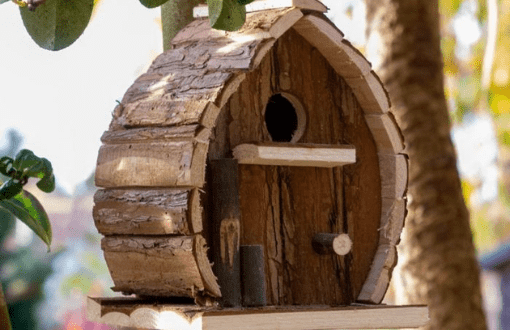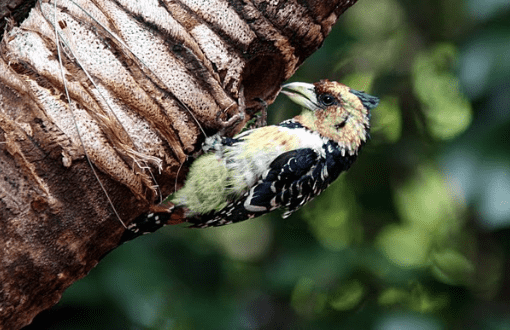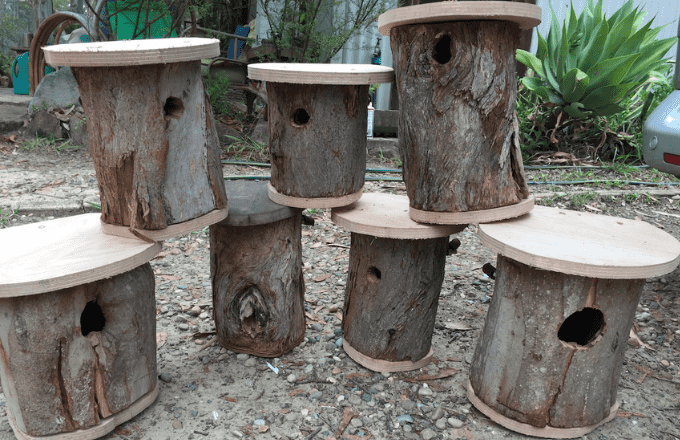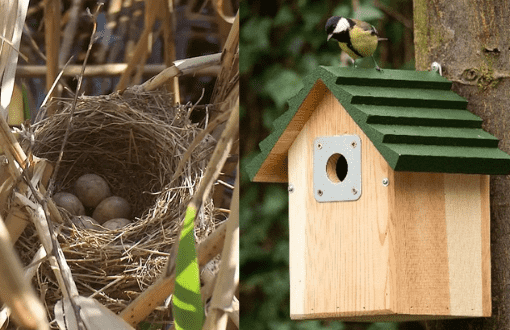What are Nesting Logs?
Nesting logs play a pivotal role in maintaining and enhancing biodiversity, particularly in urban and suburban landscapes. These logs, often remains of trees, serve as crucial habitats for a variety of species, from birds to small mammals. Let’s embark on a journey to understand their significance and admire nature’s creativity.
Table of Contents
Benefits of Using Nesting Logs in Agriculture and Farming
Habitat logs are more than mere decaying pieces of wood; in the context of agriculture and farming, they are vital contributors to a sustainable and balanced ecosystem. Their porous structure, cavities, and organic composition make them indispensable in supporting various life forms. Beyond providing refuge and breeding grounds, they also play a significant role in enhancing soil health, promoting microbial activity, and aiding decomposition.
1. Easy Pest Control:
- Logs provide habitats for beneficial insects and animals.
- These insects naturally control harmful farm pests.
- This diminishes the need for chemical pesticides, promoting eco-friendly farming.
2. Enhanced Soil Health:
- Decomposing logs introduces essential nutrients to the soil.
- This boosts soil fertility.
- They also encourage microbial activity, enhancing the soil’s overall health.
3. Moisture Retention:
- Logs function as natural water reservoirs.
- They prevent the soil from drying out too rapidly.
- Maintaining optimal soil moisture becomes crucial, especially in drought-prone areas.
4. Prevention of Soil Erosion:
- Strategically placed logs can counteract soil erosion.
- They offer stability to the soil and mitigate damage from heavy rains and runoff.
5. Attracting Wildlife:
- Logs are microhabitats for a plethora of species.
- They draw in pollinators and other useful organisms.
- Increased biodiversity leads to a harmonious and balanced farm ecosystem.
6. Improved Nutrient Cycling:
- Over time, logs break down, releasing nutrients consistently.
- This steady supply of nutrients facilitates extended crop growth.
7. Reduced Weeding:
- By shading the soil, logs can inhibit weed proliferation.
- Fewer weeds lead to less competition for crops, ensuring better growth.
8. Temperature Regulation of Soil:
- Logs have an insulating effect on the soil, moderating its temperature.
- This is particularly advantageous for plant growth and the health of roots.
9. Carbon Storage:
- Decomposing logs store carbon within the soil.
- This contributes to carbon sequestration, reducing greenhouse gas emissions.
10. Economic and Sustainable Farming:
- Incorporating natural elements like logs is cost-efficient for farmers.
- It reduces dependency on synthetic inputs.
- Encourages sustainable agricultural practices for the long term.
11. Robust Crop Health:
- Improved soil conditions and reduced pest interference lead to healthier crops.
- The outcome is superior-quality produce, a direct result of the balanced ecosystem facilitated by logs.
12. Drought Resistance:
- Log-enriched soil retains moisture effectively during droughts.
- This resilience ensures crops can endure during times of water scarcity.




Different Types of Nesting Logs
Natural
Nature’s original design of natural habitat logs comes from trees that decay naturally. They often have a distinct appearance, marked by the presence of moss, lichen, and other flora, offering a picturesque environment for wildlife.
Artificial
Created to mimic natural logs, artificial habitat logs are crafted to support species in areas where natural logs might be lacking. They can be tailored for specific species, ensuring higher occupancy rates and breeding success.

How Nesting Logs Promote Wildlife Diversity?
Habitat logs are like mini condominiums for wildlife. Birds like woodpeckers chisel out their chambers, reptiles like snakes find comfort in their gaps, and insects colonize their outer layers. This cohabitation fosters an environment where species can thrive in harmony.
Materials Used in Making Nesting Logs
Types of Wood Preferred for Nesting
Not all wood is created equal. Oak, for instance, is highly sought after for its durability and resistance to decay, making it a prime choice for habitat logs.
Preserving habitat logs for Longevity
While the natural decay process is integral to habitat logs, certain measures, like keeping them away from ground moisture, can extend their lifespan and utility.
Steps to Prepare Your Own Nesting Logs
Creating a nesting log can be a delightful DIY project.
- Start by selecting a healthy piece of wood.
- Hollowing out sections.
- Positioning it strategically in your garden or farm.
Over time, nature will take over, and soon, you’ll have residents.
Role of Nesting Logs in Ecosystem Balance
Beyond shelter, habitat logs play a role in nutrient recycling, water conservation, and soil aeration. They act as anchors, preventing soil erosion and fostering a micro-ecosystem that benefits the larger environment.
Popular Species that Use Nesting Logs
Birds
From woodpeckers to owls, many avian species seek refuge in habitat logs. They offer warmth, protection from predators, and a venue for raising chicks.
Reptiles
Logs provide cool and damp hideouts for reptiles like lizards and snakes. Their shady crevices offer the perfect escape from the scorching sun.
Mammals
Creatures like hedgehogs and some rodents use nesting logs as hibernation sites or nesting chambers, safeguarding their young from external threats.

Nesting Logs and Their Impact on Surrounding Flora
The organic decomposition of logs provides rich nutrients to the surrounding soil, promoting plant growth. Furthermore, the micro-ecosystem around logs can attract pollinators, indirectly aiding plant reproduction.
Maintenance and Care of Nesting Logs
Though they are meant to decay naturally, some care can ensure habitat logs remain habitable longer. Simple acts like repositioning logs, checking for pests, and periodic inspections can make a difference.
Potential Challenges with Nesting Logs
Like all things, habitat logs come with challenges.
- Overcrowding.
- Unwanted pests.
- Faster-than-expected decay can pose problems.
However, with knowledge and care, these can be addressed effectively.
Buying vs. Crafting: Which is Better?
While buying a ready-made nesting log can save time, crafting one offers customization. Depending on your locale and target species, the choice can vary.
Nesting Logs: Beyond Wildlife – Other Uses
Beyond wildlife, nesting logs serve aesthetic purposes in gardens & farms, acting as natural art pieces. They can also be used in educational settings to teach about biodiversity.
Do’s and Don’ts of Using Nesting Logs
While the idea of installing a nesting log is exciting, it’s essential to be mindful.
- Avoid introducing invasive species,
- Ensure logs are securely positioned.
- Remember to let nature take its course.
Success Stories of Nesting Logs Implementation
Across the globe, from urban gardens in New York to wildlife reserves in Africa, habitat logs have played pivotal roles in conservation. Their impact, though subtle, resonates across ecosystems, affirming their undeniable importance.
The Future of Nesting Logs in Ecological Conservation
As urban sprawl continues, the importance of habitat logs will only grow. They present a simple yet effective solution to counter habitat loss, ensuring a brighter future for countless species.
Frequently Asked Questions (FAQ’s)
Why are nesting logs important in farming?
They enhance soil, control pests, and offer numerous ecological benefits.
How do habitat logs support eco-friendly agriculture?
They reduce the need for chemicals and aid in carbon sequestration.
What are nesting logs made of?
Habitat logs are primarily made of wood, typically from trees like oak, which offers durability and natural cavities.
How can I maintain my nesting log?
Periodic inspections, repositioning to avoid excessive moisture, and ensuring it remains free from harmful pests are some steps.
Do habitat logs attract pests?
While they can attract some unwanted guests, with proper care and positioning, such risks can be minimized.
Conclusion
Nesting logs, in their silent existence, breathe life into many ecosystems. Whether naturally formed or human-made, their value in promoting biodiversity is unmatched. As guardians of the environment, understanding and promoting their use can pave the way for a balanced and prosperous natural world.
People Also Ask
Why are nesting logs important?
They provide shelter breeding spots and foster biodiversity, playing a crucial role in ecological conservation.
How long do habitat logs last?
While it varies, a well-maintained oak nesting log can last several years before it decays completely.
Can I make a nesting log at home?
Absolutely! With a suitable piece of wood and a few essential tools, you can create your own nesting log.
Agricomplex.com.pk Mission
Agricomplex stands as the pinnacle of agricultural services in the industry. With a mission deeply rooted in pushing the agriculture sector forward. Agricomplex is dedicated to delivering cutting-edge agricultural knowledge and expertise to the global community. As the leading provider of agricultural services, we’re dedicated to giving farmers, agribusinesses, and stakeholders the best tools, techniques, and insights.Our belief is that through the fusion of tradition and innovation, the agriculture sector can reach new heights.







